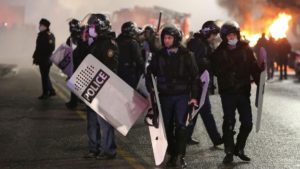Kazakhstan is witnessing the largest protest in its history since its inception in 1991. The protest took off on 2nd January 2022 in the oil town of Zhanaozen against the rising fuel price which has doubled since the government lifted price caps for LPG, commonly used fuel in the country. The protestors argue that the rising of fuel price has put stress on the common man’s pocket with the potential increase in food price. Due to the pandemic, inequality and inflation has risen at an unprecedented rate over the two years. In the year 2021, inflation was reported to 9% which was the highest in recent time.[i] With the increase in LPG price, according to protestors, inequality will be more pronounced in the country. The protestors have demanded the rollback of prices and the resignation of the government.
According to many analysts, the protest against the rising fuel price has acted as a catalyst for the already brewing discontent among a large population in the country. The discontent is largely due to the absence of democracy in the country. The rising inequality during the pandemic has made the situation worse.
After the disintegration of the USSR and the subsequent formation of Kazakhstan in 1991, Nursultan Nazarbayev became the President. He systemically gained control over the institutions; elections were held periodically was an eyewash. Any form of dissent was crushed, opposition leaders were jailed or exiled. The authoritarian rule resulted in citizens being devoid of the right to freedom of expression and other civil liberties.
Nursultan Nazarbayev resigned in the year 2019. Kassym-Jomart Tokayev, Prime Minister in the Nazarbayev cabinet was elected as President. The election was held without any opposition with 500 demonstrators in the jail. [ii] After his election, Tokayev promised an inclusive and accountable government. He even went on a ‘listening tour’ around the country. But the situation did not change on the ground, the new government continued the repressive policies. Restrictions on freedom of speech and peaceful assembly continued under the new regime. Further, the government passed a law that made it easier to monitor and control civil society and anticipate any threat to the regime and act accordingly. [iii] Corruption is rampant in the judiciary which serves only the elite. The non-inclusive and unaccountable government under Tokayev increased the disconnect between the population and the government.
The pandemic exposed the vulnerability in the Kazakh economy as a whole. The country witnessed a recession for the first time since 1998. The recession forced many Kazaks to secure a personal loan even though the wage rise has stagnated. The amount of personal loans jumped to US $ 1.7 billion in 2020. [iv] Pandemic also resulted in inflation touching 9% which forced its Central Bank to increase the interest rate to 9.7%.[v] A situation has resulted in the country, where only a few has been successful in amassing a large amount of wealth and on the other hand, there has been resentment among the larger population. The rise in LPG prices has exacerbated the growing discontent against the government.
The unrest in Kazakhstan is primarily a worry for the world because it accounts for 40% of global uranium and contains 30 billion oil reserves.[vi] The protest saw a rise of both Uranium (8%) and Oil (2%) after a few days of protest. [vii] The destabilizing situation in Kazakhstan would mean a supply gap in oil and gas and a gradual price hike affecting import-dependent countries adversely.
However, Russia has more to worry about. It shares a 7,600km long border with Kazakhstan. However, the border restrictions are removed as both these countries are part of the Eurasian Economic Union. Any instability and regime change in the neighbouring country will have a spillover effect in Russia. In the event of fundamentalist forces coming to power in Kazakhstan, Chechnya rebels can find a safe haven in the country. Further, if nationalist forces come to power, there is a danger of discrimination against Ethnic Russian comprising 20% of the Kazakhstan population.[viii]
China of late has become increasingly a major player in Central Asia. It has heavily invested in Kazakhstan in many projects under the Belt and Road Initiative(BRI). The authoritarian leaders of Kazakhstan have found it easy to secure a loan at a lower interest from China rather than liberal institutions such as IMF and World Bank. China also secures its resistive region Xinjiang region from extremist and radical ideas. But this would change if there is instability and regime change. The instability would put the Chinese investment in the country in jeopardy. Further, extremist and radical ideas can be easily exported to the Xinjiang region. Both Russia and China seek stability in Central Asia to maintain their national interest and strategic depth in the region. The instability in the region can have an adverse impact in the long run for both countries.
*Priyam Bhattacharjee has done in Masters from Pondicherry University and is currently, pursuing a month-long internship programme at USI of India.
[i] Philipose Rahel.2022. “How spike in fuel Prices led to crisis in Kazakhstan”,Indian Express,. https://indianexpress.com/article/explained/kazakhstan-fuel-prices-emergency-government-protests-explained-7709017/
[ii] Wani Ayjaz.2022. “Kazakhstan on the brink”.ORF, New Delhi https://www.orfonline.org/expert-speak/kazakhstan-on-the-brink/
[iii] Ibid.
[iv] Ibid.
[v] Ibid.
[vi] Mishra Saaransh and UnniKrishnan Nandan.2022. “The domestic and International significance of protest in Kazakhstan”, ORF. https://www.orfonline.org/expert-speak/the-domestic-and-international-significance-of-protests-in-kazakhstan/
[vii] Ibid.
[viii] Ibid.


